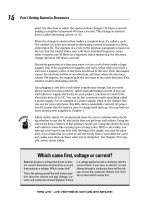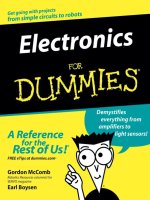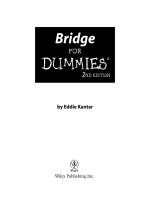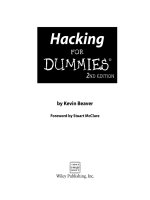Electronics for dummies 2nd ed (ISBN 0470286970)
Bạn đang xem bản rút gọn của tài liệu. Xem và tải ngay bản đầy đủ của tài liệu tại đây (18.41 MB, 435 trang )
spine=.864”
Technology/Electronics
Electronics is fascinating —
want to make something of it?
This book shows you how!
™
Open the book and find:
• The difference between electronics
and electricity
• A list of essential tools
• Cool projects you can build quickly
• Great places to find parts
• Mystery solved — understand what makes your iPod, remote
control, and computer work
• Important safety tips
• Essential stuff — outfit your electronics lab with all the necessary
tools, including some that will surprise you
• What a sine wave is
• Schematic road maps — learn to read schematics and understand how they help your project get where it’s going
• Interesting stuff about speakers,
buzzers, and DC motors
• Symbols of power — recognize all the identifiers for power
sources, grounds, and components
• Ohm’s Law and how to use it
s
c
i
n
o
Electr
• Tools of the trade — discover how to use a multimeter, logic
probe, oscilloscope, and solderless breadboard
• Break it down — get to know the ins and outs of components
such as resistors, capacitors, diodes, and transistors
Learn to:
• Getting it together — find out how integrated circuits make all
the rest possible and learn to work with them
• Analyze it — understand the rules that govern current and voltage and learn how to apply them
• Work with resistors, capacitors, diodes,
and integrated circuits
Go to Dummies.com®
for videos, step-by-step examples,
how-to articles, or to shop!
• Build and troubleshoot circuits
• Use a multimeter, oscilloscope, and
logic probe
• Protect your safety
$24.99 US / $29.99 CN / £17.99 UK
ISBN 978-0-470-28697-5
Cathleen Shamieh is a high-tech writer with extensive engineering and
consulting experience in the fields of medical electronics, speech processing,
and telecommunications. Gordon McComb writes the Robotics Resources
column for SERVO Magazine, the leading hobby electronics magazine in
the US.
2nd Edition
2nd Edition
Electronics
You can make all sorts of things, once you understand what
electronics is and how it works. This book helps you out with
that part, explaining the whole business in plain English.
Learn how electricity functions, how to harness it and put it
to work, what tools you need to build circuits, what you can
make with them, and how to do it safely.
g Easier!
Making Everythin
Shamieh
McComb
Cathleen Shamieh
Gordon McComb
spine=.864”
®
Get More and Do More at Dummies.com
dition
Start with FREE Cheat Sheets
2nd E
Cheat Sheets include
• Checklists
• Charts
• Common Instructions
• And Other Good Stuff!
To access the Cheat Sheet created specifically for this book, go to
www.dummies.com/cheatsheet/electronics
Get Smart at Dummies.com
Dummies.com makes your life easier with 1,000s
of answers on everything from removing wallpaper
to using the latest version of Windows.
Check out our
• Videos
• Illustrated Articles
• Step-by-Step Instructions
Plus, each month you can win valuable prizes by entering
our Dummies.com sweepstakes. *
Want a weekly dose of Dummies? Sign up for Newsletters on
• Digital Photography
• Microsoft Windows & Office
• Personal Finance & Investing
• Health & Wellness
• Computing, iPods & Cell Phones
• eBay
• Internet
• Food, Home & Garden
Find out “HOW” at Dummies.com
*Sweepstakes not currently available in all countries; visit Dummies.com for official rules.
Electronics
FOR
DUMmIES
‰
2ND
EDITION
Electronics
FOR
DUMmIES
‰
2ND
EDITION
by Cathleen Shamieh and Gordon McComb
Electronics For Dummies®, 2nd Edition
Published by
Wiley Publishing, Inc.
111 River Street
Hoboken, NJ 07030-5774
www.wiley.com
Copyright © 2009 by Wiley Publishing, Inc., Indianapolis, Indiana
Published by Wiley Publishing, Inc., Indianapolis, Indiana
Published simultaneously in Canada
No part of this publication may be reproduced, stored in a retrieval system, or transmitted in any form or
by any means, electronic, mechanical, photocopying, recording, scanning or otherwise, except as permitted under Sections 107 or 108 of the 1976 United States Copyright Act, without either the prior written
permission of the Publisher, or authorization through payment of the appropriate per-copy fee to the
Copyright Clearance Center, 222 Rosewood Drive, Danvers, MA 01923, (978) 750-8400, fax (978) 646-8600.
Requests to the Publisher for permission should be addressed to the Permissions Department, John Wiley
& Sons, Inc., 111 River Street, Hoboken, NJ 07030, (201) 748-6011, fax (201) 748-6008, or online at http://
www.wiley.com/go/permissions.
Trademarks: Wiley, the Wiley Publishing logo, For Dummies, the Dummies Man logo, A Reference for the
Rest of Us!, The Dummies Way, Dummies Daily, The Fun and Easy Way, Dummies.com, Making Everything
Easier, and related trade dress are trademarks or registered trademarks of John Wiley & Sons, Inc. and/
or its affiliates in the United States and other countries, and may not be used without written permission.
All other trademarks are the property of their respective owners. Wiley Publishing, Inc., is not associated
with any product or vendor mentioned in this book.
Limit of Liability/Disclaimer of Warranty: The publisher and the author make no
representations or warranties with respect to the accuracy or completeness of
the contents of this work and specifically disclaim all warranties, including without limitation warranties of fitness for a particular purpose. No warranty may be
created or extended by sales or promotional materials. The advice and strategies
contained herein may not be suitable for every situation. This work is sold with the
understanding that the publisher is not engaged in rendering legal, accounting, or
other professional services. If professional assistance is required, the services of
a competent professional person should be sought. Neither the publisher nor the
author shall be liable for damages arising herefrom. The fact that an organization
or Website is referred to in this work as a citation and/or a potential source of further information does not mean that the author or the publisher endorses the information the organization or Website may provide or recommendations it may make.
Further, readers should be aware that Internet Websites listed in this work may have
changed or disappeared between when this work was written and when it is read.
For general information on our other products and services, please contact our Customer Care
Department within the U.S. at 877-762-2974, outside the U.S. at 317-572-3993, or fax 317-572-4002.
For technical support, please visit www.wiley.com/techsupport.
Wiley also publishes its books in a variety of electronic formats. Some content that appears in print may
not be available in electronic books.
Library of Congress Control Number: 2009933743
ISBN: 978-0-470-28697-5
Manufactured in the United States of America
10 9 8 7 6 5 4 3 2 1
About the Authors
Cathleen Shamieh is a writer with an engineering background who specializes in creating communication materials focused on the business benefits
of technology. She received an outstanding education in electrical engineering at Manhattan College and MIT, and worked as an engineer in the medical
electronics and telecommunications industries before shifting her career into
marketing communications and business consulting for high-tech companies.
Cathleen enjoys leveraging her technical and business background to create
white papers and other materials for not-so-technical audiences.
Gordon McComb has penned more than 60 books and over 1,000 magazine
articles. More than a million copies of his books are in print, in over a dozen
languages. For 13 years, Gordon wrote a weekly syndicated newspaper
column on personal computers. When not writing about hobby electronics
and other fun topics, he serves as a consultant on digital cinema to several
notable Hollywood clients.
Dedication
To my parents, Beth and Jim Corbett, who taught me that I can do anything
I put my mind to; to Sister Eustelle, who made a writer out of me; to my
wonderful husband, Bill, who’s always there to support me; and to my four
fantastic sons, Kevin, Peter, Brendan, and Patrick, who make life a fun, loving
adventure every single day.
C. S.
To my father, Wally McComb, who instilled in me a fascination with electronics; and to Forrest Mims, who taught me a thing or two about it.
G. M.
Authors’ Acknowledgments
Cathleen Shamieh extends her thanks to the excellent editors at Wiley,
especially Katie Feltman and Christopher Morris, for their hard work, support, and gentle reminders, and to Kirk Kleinschmidt, for his intense technical scrutiny of the material. She is also grateful to Linda Hammer and Ken
Donoghue, who kindly recommended her work to Wiley. Finally, Cathleen
thanks her family and friends, whose support, assistance, and understanding
helped make her goal of becoming a For Dummies author a reality.
Author Gordon wishes to thank his family, who once again put their lives on
hold while he finished another book.
Publisher’s Acknowledgments
We’re proud of this book; please send us your comments through our online registration form
located at . For other comments, please contact our Customer Care
Department within the U.S. at 877-762-2974, outside the U.S. at 317-572-3993, or fax 317-572-4002.
Some of the people who helped bring this book to market include the following:
Acquisitions, Editorial
Sr. Project Editor: Christopher Morris
Composition Services
Acquisitions Editor: Katie Feltman
Project Coordinator: Katie Crocker
Sr. Copy Editor: Barry Childs-Helton
Layout and Graphics: Karl Brandt,
Shawn Frazier, SDJumper
Technical Editor: Kirk Kleinschmidt
Editorial Manager: Kevin Kirschner
Sr. Editorial Assistant: Cherie Case
Proofreader: John Greenough
Indexer: Potomac Indexing
Cartoons: Rich Tennant
(www.the5thwave.com)
Publishing and Editorial for Technology Dummies
Richard Swadley, Vice President and Executive Group Publisher
Andy Cummings, Vice President and Publisher
Mary Bednarek, Executive Acquisitions Director
Mary C. Corder, Editorial Director
Publishing for Consumer Dummies
Diane Graves Steele, Vice President and Publisher
Composition Services
Debbie Stailey, Director of Composition Services
Contents at a Glance
Introduction................................................................. 1
Part I: Understanding the Fundamentals of Electronics.... 7
Chapter 1: What Is Electronics and What Can It Do for You?....................................... 9
Chapter 2: Manipulating Electricity to Make Something Happen............................... 21
Chapter 3: Meeting Up with Resistance......................................................................... 39
Chapter 4: Getting a Charge Out of Capacitors............................................................. 65
Chapter 5: Curling Up with Coils and Crystals.............................................................. 91
Chapter 6: The Wide World of Semiconductors......................................................... 111
Chapter 7: Packing Parts Together on Integrated Circuits........................................ 143
Chapter 8: Rounding Out Your Parts List.................................................................... 169
Part II: Getting Your Hands Dirty.............................. 191
Chapter 9: Setting Up Shop and Ensuring Your Safety.............................................. 193
Chapter 10: Reading Schematics.................................................................................. 219
Chapter 11: Constructing Circuits................................................................................ 239
Chapter 12: Measuring and Analyzing Circuits........................................................... 259
Chapter 13: Getting Down with Logic Probes and Oscilloscopes............................ 281
Part III: Putting Theory into Practice......................... 301
Chapter 14: Exploring Some Learning Circuits........................................................... 303
Chapter 15: Great Projects You Can Build in 30 Minutes or Less............................ 327
Part IV: The Part of Tens........................................... 351
Chapter 16: Ten (Or So) Terrific Tips to Help You Succeed..................................... 353
Chapter 17: Ten (Or So) Great Electronics Parts Sources......................................... 363
Appendix: Internet Resources..................................... 369
Glossary................................................................... 375
Index....................................................................... 387
Table of Contents
Introduction.................................................................. 1
Why Buy This Book?........................................................................................ 1
Why Electronics?.............................................................................................. 2
Foolish Assumptions........................................................................................ 3
Safety Is Number 1............................................................................................ 3
How This Book Is Organized........................................................................... 4
Part I: Understanding the Fundamentals of Electronics.................... 4
Part II: Getting Your Hands Dirty.......................................................... 5
Part III: Putting Theory into Practice................................................... 5
Part IV: The Part of Tens........................................................................ 5
Icons Used in This Book.................................................................................. 6
Part I: Understanding the Fundamentals of Electronics.... 7
Chapter 1: What Is Electronics and What Can It Do for You? . . . . . . . . 9
Just What Is Electronics?............................................................................... 10
Checking Out Electric Current...................................................................... 11
Getting a charge out of electrons....................................................... 11
Mobilizing electrons in conductors.................................................... 12
Giving electrons a nudge..................................................................... 13
Harnessing Electrical Energy to Do Work................................................... 14
Tapping into electrical energy............................................................ 15
Making sure electrons arrive at their destination............................ 15
Oh, the Things Electrons Can Do (Once You Put Their Minds to It)!...... 17
Creating good vibrations..................................................................... 18
Seeing is believing................................................................................. 18
Sensing and alarming........................................................................... 18
Controlling motion................................................................................ 18
Solving problems (a.k.a. computing)................................................. 19
Communicating..................................................................................... 19
Chapter 2: Manipulating Electricity to Make Something Happen . . . 21
Supplying Electrical Energy.......................................................................... 22
Getting direct current from a battery................................................ 22
Using alternating current from a power plant.................................. 24
Transforming light into electricity..................................................... 26
Understanding Directions: Real Electron Flow
versus Conventional Current Flow........................................................... 26
Examining a Simple Light-Bulb Circuit......................................................... 27
xii
Electronics For Dummies, 2nd Edition
Controlling Electrical Current with Basic Components............................ 31
Ways to control current....................................................................... 31
Active versus passive components.................................................... 32
Making Connections: Series and Parallel..................................................... 33
Series connections................................................................................ 33
Parallel connections............................................................................. 33
Combination circuits............................................................................ 34
Creating Electronic Systems......................................................................... 35
Making sound appear out of thin air.................................................. 36
Painting pictures with electrons......................................................... 37
Chapter 3: Meeting Up with Resistance . . . . . . . . . . . . . . . . . . . . . . . . . 39
Resisting the Flow of Current........................................................................ 40
Resistors: Passive Yet Powerful................................................................... 41
What are resistors used for?............................................................... 41
Choosing a type of resistor: Fixed or variable.................................. 43
Reading into fixed resistors................................................................. 44
Dialing with potentiometers................................................................ 46
Rating resistors according to power.................................................. 49
Combining Resistors...................................................................................... 50
Resistors in series................................................................................. 50
Resistors in parallel.............................................................................. 51
Combining series and parallel resistors............................................ 53
Obeying Ohm’s Law....................................................................................... 54
Driving current through a resistance................................................. 54
It’s constantly proportional!................................................................ 55
One law, three equations..................................................................... 56
Using Ohm’s Law to Analyze Circuits.......................................................... 56
Calculating current through a component........................................ 57
Calculating voltage across a component........................................... 58
Calculating an unknown resistance.................................................... 60
What Is Ohm’s Law Really Good For?.......................................................... 60
Analyzing complex circuits................................................................. 60
Designing and altering circuits........................................................... 62
The Power of Joule’s Law.............................................................................. 63
Using Joule’s Law to choose components......................................... 63
Joule and Ohm: perfect together........................................................ 64
Trying Your Hand at Circuits with Resistors.............................................. 64
Chapter 4: Getting a Charge Out of Capacitors . . . . . . . . . . . . . . . . . . . 65
Capacitors: Reservoirs for Electrical Energy.............................................. 66
Charging and Discharging Capacitors......................................................... 67
Opposing voltage change.................................................................... 69
Giving alternating current a pass....................................................... 69
What Are Capacitors Used For?.................................................................... 70
Table of Contents
Characterizing Capacitors............................................................................. 71
How much charge can a capacitor plate store?................................ 72
Keeping an eye on the working voltage............................................. 73
Choosing the right type (dielectric) for the job............................... 73
Sizing up capacitor packaging............................................................. 74
Being positive about capacitor polarity............................................ 75
Reading into capacitor values............................................................. 76
Varying capacitance............................................................................. 78
Combining Capacitors.................................................................................... 79
Capacitors in parallel........................................................................... 79
Capacitors in series.............................................................................. 80
Understanding Capacitive Reactance.......................................................... 81
Using Ohm’s Law for capacitive reactance....................................... 82
Teaming Up with Resistors........................................................................... 83
Timing is everything............................................................................. 84
Calculating RC time constants............................................................ 86
Creating a timer.................................................................................... 86
Selecting Frequencies with Simple RC Filters............................................. 87
Low-pass filter....................................................................................... 88
High-pass filter...................................................................................... 88
Cutting off frequencies at the knees................................................... 89
Filtering frequency bands.................................................................... 90
Trying Your Hand at Simple Capacitive Circuits........................................ 90
Chapter 5: Curling Up with Coils and Crystals . . . . . . . . . . . . . . . . . . . . 91
Kissing Cousins: Magnetism and Electricity............................................... 92
Drawing the (flux) lines with magnets............................................... 92
Producing a magnetic field with electricity....................................... 93
Inducing current with a magnet.......................................................... 94
Introducing the Inductor: A Coil with a Magnetic Personality................. 95
Measuring inductance.......................................................................... 95
Opposing current changes.................................................................. 95
Keeping up with alternating current (or not!)................................... 97
Understanding Inductive Reactance............................................................ 98
Using Ohm’s Law for inductive reactance......................................... 99
Behaving differently depending on frequency (again!).................... 99
Using Inductors in Circuits............................................................................ 99
Insulating and shielding inductors................................................... 100
Reading inductance values................................................................ 100
Combining shielded inductors.......................................................... 100
Filtering signals with inductors........................................................ 101
Calculating the RL time constant...................................................... 102
Now Introducing Impedance!...................................................................... 103
Tuning in to Radio Broadcasts................................................................... 104
Resonating with RLC circuits............................................................ 104
Ensuring rock-solid resonance with crystals.................................. 105
xiii
xiv
Electronics For Dummies, 2nd Edition
Influencing the Coil Next Door: Transformers.......................................... 107
Letting unshielded coils interact...................................................... 107
Isolating circuits from a power source............................................ 108
Stepping up, stepping down voltages.............................................. 108
Chapter 6: The Wide World of Semiconductors . . . . . . . . . . . . . . . . . 111
Are We Conducting or Aren’t We?.............................................................. 112
Doping semiconductors..................................................................... 113
Combining N-types and P-types to create components................. 114
Forming a Junction Diode............................................................................ 116
Biasing the diode................................................................................ 117
Conducting current through a diode............................................... 118
Rating your diode............................................................................... 119
Identifying with diodes....................................................................... 119
Which end is up?................................................................................. 120
Using Diodes in Circuits............................................................................... 120
Rectifying AC....................................................................................... 121
Regulating voltage with Zener diodes.............................................. 122
Seeing the light with LEDs................................................................. 123
Other uses of diodes.......................................................................... 125
Tremendously Talented Transistors......................................................... 126
Bipolar junction transistors.............................................................. 126
Field-effect transistors....................................................................... 127
Operating a Transistor................................................................................. 128
How Transistors Really Work..................................................................... 129
Emitting and collecting electrons..................................................... 129
Gaining current................................................................................... 132
Saturating the transistor.................................................................... 132
Using a Model to Understand Transistors................................................ 133
Amplifying Signals with a Transistor......................................................... 135
Biasing the transistor so it acts like an amplifier........................... 136
Controlling the voltage gain.............................................................. 136
Configuring transistor amplifier circuits......................................... 137
Switching Signals with a Transistor........................................................... 137
Choosing Transistors................................................................................... 138
Important transistor ratings.............................................................. 138
Identifying transistors........................................................................ 139
Recognizing a transistor when you see one.................................... 140
Making All Kinds of Components Possible................................................ 141
Trying Your Hand at Semiconductor Circuits.......................................... 141
Chapter 7: Packing Parts Together on Integrated Circuits . . . . . . . . 143
Why ICs?........................................................................................................ 144
Linear, Digital, or Combination Plate?....................................................... 145
Making Decisions with Logic....................................................................... 145
Beginning with bits............................................................................. 147
Processing data with gates................................................................ 148
Simplifying gates with truth tables................................................... 150
Creating logical components............................................................. 151
Table of Contents
Understanding How to Use ICs................................................................... 152
Identifying ICs with part numbers.................................................... 152
Packaging is everything..................................................................... 153
Probing IC pinouts.............................................................................. 154
Relying on IC datasheets.................................................................... 156
Hanging Out with Some Popular ICs.......................................................... 157
Operational amplifiers....................................................................... 157
IC time machine: The 555 timer........................................................ 159
Counting on the 4017 decade counter............................................. 165
Microcontrollers and other popular ICs.......................................... 166
Expanding Your IC Horizons....................................................................... 166
Chapter 8: Rounding Out Your Parts List . . . . . . . . . . . . . . . . . . . . . . . . 169
Making Connections..................................................................................... 169
Choosing wires wisely........................................................................ 170
Plugging in to connectors.................................................................. 172
Powering Up.................................................................................................. 173
Turning on the juice with batteries.................................................. 173
Getting power from the sun............................................................... 177
Working off your wall power (not recommended)......................... 177
Switching Electricity On and Off................................................................. 179
Controlling the action of a switch.................................................... 179
Making the right contacts.................................................................. 180
Using Your Sensors...................................................................................... 181
Seeing the light.................................................................................... 182
Capturing sound with microphones................................................. 183
Feeling the heat................................................................................... 183
More energizing input transducers.................................................. 185
Experiencing the Outcome of Electronics................................................. 186
Speaking of speakers.......................................................................... 186
Sounding off with buzzers................................................................. 188
Creating good vibrations with DC motors....................................... 189
Part II: Getting Your Hands Dirty............................... 191
Chapter 9: Setting Up Shop and Ensuring Your Safety . . . . . . . . . . . . 193
Picking a Place to Practice Electronics...................................................... 194
The top ingredients for a great lab................................................... 194
Workbench basics.............................................................................. 195
Acquiring Tools and Supplies..................................................................... 195
Stockpiling soldering equipment...................................................... 196
Amassing a multimeter...................................................................... 198
Hoarding hand tools........................................................................... 199
Collecting cloths and cleansers........................................................ 200
Loading up on lubricants................................................................... 202
Stocking up on sticky stuff................................................................. 203
Other tools and supplies................................................................... 204
xv
xvi
Electronics For Dummies, 2nd Edition
Stocking Up on Parts and Components..................................................... 205
Solderless breadboards..................................................................... 205
Circuit-building starter kit................................................................. 207
Adding up the extras.......................................................................... 208
Organizing all your parts................................................................... 209
Protecting You and Your Electronics........................................................ 209
Understanding that electricity can really hurt............................... 210
Soldering safely................................................................................... 214
Avoiding static like the plague.......................................................... 215
Chapter 10: Reading Schematics . . . . . . . . . . . . . . . . . . . . . . . . . . . . . . 219
What’s a Schematic and Why Should I Care?............................................ 219
Seeing the Big Picture.................................................................................. 220
It’s all about your connections......................................................... 221
Looking at a simple battery circuit................................................... 221
Recognizing Symbols of Power................................................................... 223
Showing where the power is............................................................. 224
Marking your ground.......................................................................... 226
Labeling Circuit Components..................................................................... 228
Analog electronic components......................................................... 228
Digital logic and IC components....................................................... 231
Miscellaneous components............................................................... 233
Knowing Where to Take Measurements.................................................... 235
Exploring a Schematic.................................................................................. 236
Alternative Schematic Drawing Styles....................................................... 238
Chapter 11: Constructing Circuits . . . . . . . . . . . . . . . . . . . . . . . . . . . . . . 239
Taking a Look at Solderless Breadboards................................................. 240
Exploring a solderless breadboard, inside and out....................... 240
Sizing up solderless breadboard varieties...................................... 241
Building Circuits with Solderless Breadboards........................................ 243
Preparing your parts and tools......................................................... 243
Saving time with pre-stripped wires................................................. 243
Laying out your circuit....................................................................... 244
Avoiding damaged circuits................................................................ 246
Soldering 101................................................................................................. 247
Preparing to solder............................................................................. 248
Soldering for success......................................................................... 249
Inspecting the joint............................................................................. 250
Desoldering when necessary............................................................. 251
Cooling down after soldering............................................................ 251
Practicing safe soldering.................................................................... 252
Making a Commitment: Creating a Permanent Circuit............................ 252
Moving your circuit to a solder breadboard................................... 253
Prototyping with pre-drilled perf boards........................................ 254
Getting your wires wrapped.............................................................. 255
Making a custom circuit board......................................................... 257
Table of Contents
Chapter 12: Measuring and Analyzing Circuits . . . . . . . . . . . . . . . . . . 259
Multitasking with a Multimeter................................................................... 260
It’s a voltmeter!................................................................................... 260
It’s an ammeter!................................................................................... 261
Ohm my! It’s an ohmmeter, too!........................................................ 262
Exploring Multimeters................................................................................. 263
Choosing a style: analog or digital.................................................... 263
Taking a closer look at a digital multimeter.................................... 264
Homing in on the range...................................................................... 266
Setting Up Your Multimeter........................................................................ 267
Operating Your Multimeter......................................................................... 268
Measuring voltage............................................................................... 269
Measuring current.............................................................................. 270
Measuring resistance......................................................................... 272
Running other multimeter tests........................................................ 278
Using a Multimeter to Check Your Circuits............................................... 279
Chapter 13: Getting Down with Logic Probes and Oscilloscopes . . 281
Probing the Depths of Logic........................................................................ 281
Scoping Out Signals with an Oscilloscope................................................ 285
Observing the ups and downs of voltage........................................ 285
Understanding oscilloscope bandwidth and resolution................ 288
Knowing When to Use an Oscilloscope..................................................... 289
Getting Your Oscilloscope to Work............................................................ 290
Basic setup and initial testing........................................................... 290
Displaying and measuring signals.................................................... 293
Testing, Testing, 1-2-3!.................................................................................. 295
Does your battery have any juice?................................................... 295
Dissecting your radio to display an audio waveform.................... 296
Testing the frequency of an AC circuit............................................ 297
Part III: Putting Theory into Practice.......................... 301
Chapter 14: Exploring Some Learning Circuits . . . . . . . . . . . . . . . . . . 303
Getting Ready to Explore............................................................................. 303
Seeing Is Believing: Ohm’s Law Really Works!.......................................... 305
Analyzing a series circuit................................................................... 306
Dividing up voltage............................................................................. 309
Parallel parking resistors................................................................... 311
Charging and Discharging a Capacitor...................................................... 313
Watching your charges go up and down......................................... 313
Varying the RC time constant........................................................... 315
Dropping Voltages across Diodes.............................................................. 317
Turning on an LED.............................................................................. 317
Clipping voltages................................................................................ 319
xvii
xviii
Electronics For Dummies, 2nd Edition
Gaining Experience with Transistors......................................................... 321
Amplifying current.............................................................................. 321
The switch is on!................................................................................. 322
Using Your Logic........................................................................................... 323
Seeing the light at the end of the NAND gate.................................. 324
Turning three NAND gates into an OR gate..................................... 325
Chapter 15: Great Projects You Can Build in 30 Minutes or Less . . . 327
Getting What You Need Right Off the Bat.................................................. 328
Creating Cool, Crazy, Blinky Lights............................................................ 328
Taking a closer look at the 555 flasher............................................. 329
Building the blinky-light circuit........................................................ 330
Checking your handiwork.................................................................. 333
Tapping Out a Light Tune with Piezoelectricity....................................... 334
Piezo — what?..................................................................................... 334
Shedding light on piezoelectricity.................................................... 334
Setting up a drum line........................................................................ 336
Seeing in the Dark with an Infrared Detector............................................ 336
Detecting parts for the infrared detector........................................ 336
Sniffing out infrared light sources.................................................... 337
Scaring off the bad guys with a siren......................................................... 338
Scoping out the 555 siren parts list.................................................. 339
How your warbler works................................................................... 340
Get Lost . . . or Found, with the Electronic Compass............................... 340
Checking your electronic compass parts........................................ 341
Peeking under the compass hood.................................................... 342
When There’s Light, You Hear This Noise . . ........................................... 343
Assembling the light alarm parts list............................................... 343
Making your alarm work for you....................................................... 344
Li’l Amp, Big Sound...................................................................................... 345
Sounding the roll call for Li’l Amp’s parts....................................... 345
The ins and outs of Li’l Amp.............................................................. 346
Building the Handy-Dandy Water Tester................................................... 346
Gathering water-tester parts............................................................. 347
How the water tester works.............................................................. 347
Creating a Very Cool Lighting-Effects Generator...................................... 348
Chasing down parts for your light chaser....................................... 349
Controlling the lights.......................................................................... 349
Arranging the LEDs............................................................................. 349
Part IV: The Part of Tens............................................ 351
Chapter 16: Ten (Or So) Terrific Tips to Help You Succeed . . . . . . . . 353
Trying Your Hand at Ready-Made Electronics Kits.................................. 354
Using A Power Supply with a Changeable Personality............................ 354
Counting Up Those Megahertz................................................................... 355
Table of Contents
Generating All Kinds of Signals................................................................... 356
Sweeping Frequencies Up and Down......................................................... 357
Putting a Pulse Here, Putting a Pulse There.............................................. 357
Analyzing Your Logic................................................................................... 359
Simulating Circuit Operation...................................................................... 359
Where to Get Testing-Tool Deals................................................................ 360
Chapter 17: Ten (Or So) Great Electronics Parts Sources . . . . . . . . . 363
North America............................................................................................... 363
All Electronics..................................................................................... 363
Allied Electronics................................................................................ 364
BG Micro.............................................................................................. 364
Digi-Key................................................................................................ 364
Electronic Goldmine........................................................................... 364
Jameco Electronics............................................................................. 365
Mouser Electronics............................................................................. 365
Parts Express....................................................................................... 365
RadioShack.......................................................................................... 366
Outside North America................................................................................ 366
Dick Smith Electronics (Australia)................................................... 366
Farnell (U.K.)....................................................................................... 366
Maplin (U.K.)....................................................................................... 366
What’s RoHS Compliance?........................................................................... 367
New or Surplus?............................................................................................ 367
Appendix: Internet Resources..................................... 369
Getting Up to Speed with Tutorials and General Information................ 369
Figuring Things Out with Calculators........................................................ 370
Surfing for Circuits....................................................................................... 370
Gabbing about Electronics in Discussion Forums................................... 371
Trolling for Stuff to Make Your Own Printed Circuit Boards.................. 372
Getting Things Surplus................................................................................ 372
Glossary................................................................... 375
Index........................................................................ 387
xix
xx
Electronics For Dummies, 2nd Edition
Introduction
A
re you curious to know what makes your iPod tick? How about your
cellphone, laptop, stereo system, digital camera, 46-inch plasma TV —
well, just about every other electronic thing you use to entertain yourself and
enrich your life?
If you’ve ever wondered how transistors, capacitors, and other building
blocks of electronics work, or if you’ve been tempted to try building your
own electronic devices, you’ve come to the right place!
Electronics For Dummies, 2nd Edition, is your entrée into the electrifying
world of modern electronics. No dry, boring, or incomprehensible tome, this;
what you hold in your hands is the book that enables you to understand,
create, and troubleshoot your own electronic devices.
Why Buy This Book?
All too often, electronics seems like a mystery because it involves controlling
something you can’t see — electric current — which you’ve been warned
repeatedly not to touch. That’s enough to scare away most people. But as
you continue to experience the daily benefits of electronics, you may begin
to wonder how it’s possible to make so many incredible things happen in so
many small spaces.
This book is designed to explain electronics in ways you can relate to. It gives
you a basic understanding of exactly what electronics is, offers down-to-earth
explanations of how major electronic components work, and provides just what
you need to build and test working electronic circuits and projects. Although
this book doesn’t pretend to answer all your questions about electronics, it
gives you a good grounding in the essentials.
It is our hope that when you’re done with this book, you realize that electronics
really isn’t as complicated as you may have once thought. And, it is our intent
to arm you with the knowledge and confidence you need to charge ahead in
the exciting field of electronics.
2
Electronics For Dummies, 2nd Edition
Why Electronics?
Electronics is everywhere. You find electronics in your communication
devices, entertainment systems, and kitchen appliances. Electronic systems
control traffic lights, Internet commerce, medical devices — even many toys.
Try for just one minute to imagine your life without electronics — you might
as well be living in the Dark Ages!
So, what does all this mean to you as you peruse this book? After all, you don’t
expect to be able to design satellite communication systems after a sit-down
session with this humble For Dummies book. Although that statement is true,
it’s also true that even the most complicated electronic systems consist of
no more than a handful of different electronic component types governed by
the same set of rules that determine the functionality of simple circuits. So, if
you want to glean an understanding of complex electronic systems, you start
with the basics — just like the designers of those systems did when they got
started.
More importantly, understanding the basics of electronics can enable you to
create some truly useful, albeit simple, electronic devices. You can build
circuits that flash lights at just the right time, sound a buzzer upon sensing
an intruder, or even move an object around the room. And, when you know
how to use integrated circuit (IC) chips, which are populated with easy-to-use,
fully functioning miniaturized circuits, you can create some rather involved
designs that will impress your friends and enemies — for just a few wellspent bucks.
With technology development being what it is — lightning fast and smaller
and less expensive year after year — you can now hold the ingredients for
advanced electronic systems in the palm of your hand. With a little knowledge
and a willingness to experiment, you can build something that controls the
lighting in your entire house, a robot that vacuums your living room, or an
alarm system that senses someone trying to open your refrigerator.
You may have another hobby that can be enriched by your knowledge of
electronics. If you’re into model railroading, for example, you can use your
knowledge of electronics to build your own automated track switchers. If
your hobby is racing radio-controlled cars, electronics know-how may enable
you to improve the performance of your car and beat your best friend in the
next race.
Last, but not least, electronics is fun. Gaining knowledge about and experiencing
electronics is its own reward.
Introduction
Foolish Assumptions
This book assumes that you’re curious about electronics but don’t know
much, if anything, about its inner workings. Because you chose this book,
rather than a book consisting exclusively of recipes for electronic circuits,
we assume that you want to find out more about how parts such as resistors,
capacitors, and transistors actually work, so we take the time (and more than
half this book) to explain it to you, distilling fairly technical information into
easy-to-understand concepts. You don’t need to be well versed in physics or
mathematics to benefit from reading this book, although a teeny bit of high
school algebra would be helpful (but we do our best to refresh that possibly
painful memory).
We assume that you may want to jump around this book a bit, diving deep into
a topic or two that holds special interest for you and possibly skimming through
other topics. For this reason, we provide loads of chapter cross-references to
point you to information that can fill in any gaps or refresh your memory on
a topic. And, though the first half of this book is devoted to how electronic
circuits and individual parts work, we include cross-references to learning
circuits and projects that appear later in the book. That way, as soon as you
understand a component, you can jump ahead, if you want, and build a circuit
that uses that component.
The table of contents at the front of this book provides an excellent resource
that you can use to quickly locate exactly what you’re looking for. You’ll also
find the glossary useful when you get stuck on a particular term and need to
review its definition. Finally, the folks at Wiley have thoughtfully provided a
thorough index at the back of the book to assist you in narrowing your reading to specific pages.
Safety Is Number 1
Reading about electronics is safe. Probably the worst thing that can happen
is that your eyes grow tired from too many late nights spent reading this
book. Building electronic projects is another matter, though. Lurking behind
the fun of your electronics hobby are high voltages that can electrocute you,
soldering irons that can burn you, and little bits of wire that can fly into your
eyes when you snip them off with sharp cutters. Ouch!
Safety is numero uno in electronics. It’s so important, in fact, that we devote
a major section of Chapter 9 to it — and continually refer you to that section.
3









